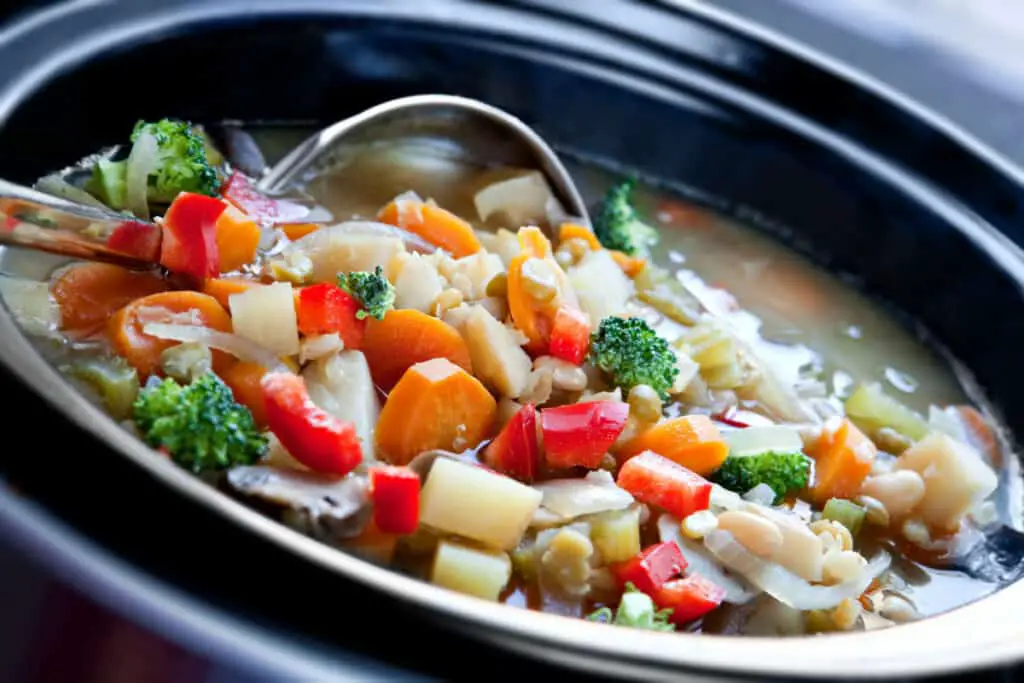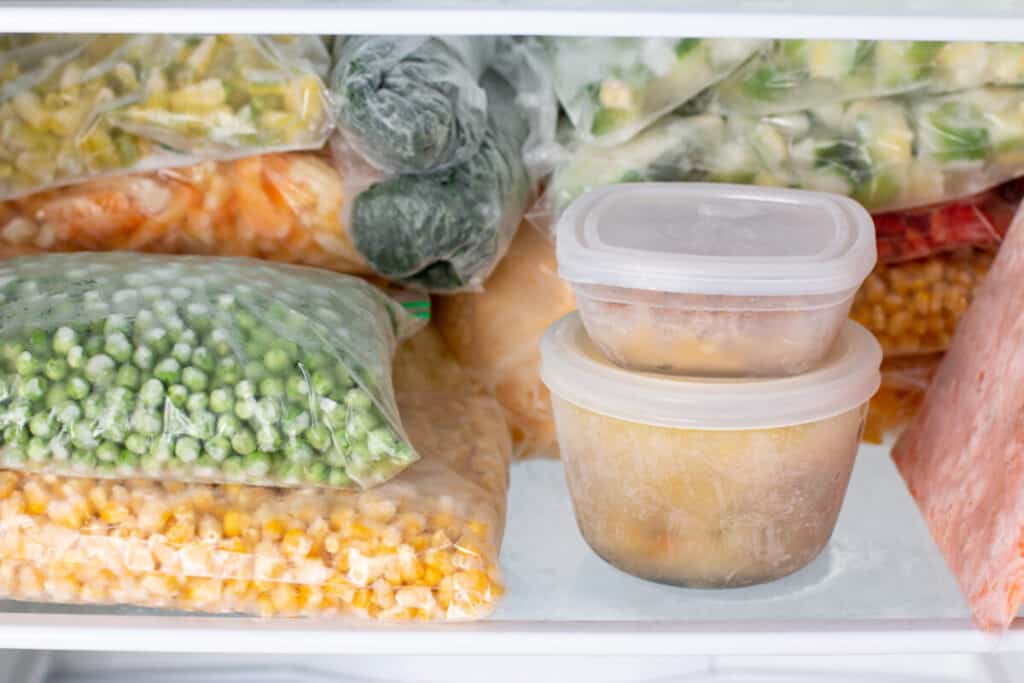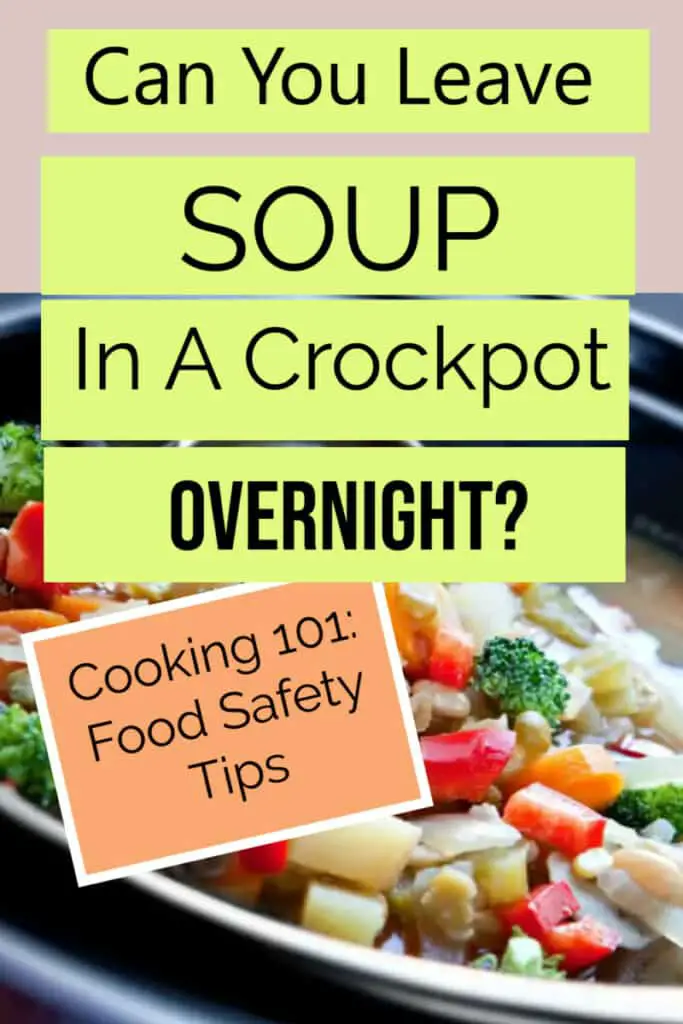This post contains affiliate links.
Crockpot soup for dinner is a great way to plan ahead for a busy day, but now dinner is over and you’re too tired to put away the leftovers. Or maybe you left it out to cool last night and forgot about it? Either way, you’re not the first person to wonder whether soup can be left out overnight.
Soup can be left in a crockpot overnight as long as the heat is on and it’s properly taken care of it afterward. Soup left at room temperature for more than two hours will have to be boiled again to eliminate dangerous bacteria, and soup that is heated for too long can degrade in quality.
There are a few different ways your own pot of soup might have been left out, so here are the specifics on each of them as to the threats of leaving your soup in the crockpot and how you can remedy it.
Can I Leave Leftover Soup on Keep Warm?
The concern you’re more likely to have is whether you can leave your leftovers in the crockpot overnight. After all, you’ve just spent all day making a big batch of soup for dinner. You don’t want to deal with cleaning up after all that work. Maybe if you just turn the heat on low it’ll stay good until you have the time to put it away, right?

First, let’s go over some elementary food safety. The danger zone when it comes to temperature is between 40 degrees and 140 degrees Fahrenheit. That means food shouldn’t be left out for long when it’s between those temperatures, because that’s where bacteria thrive. Keeping food out of the danger zone is the most important way to prevent foodborne illness.
For that reason, food is usually stored below 40 degrees Fahrenheit. For reference, refrigerators keep foods below 40 degrees Fahrenheit.
On the hot end of the thermometer, it gets a little more complicated. You can keep perishable food at temperatures above 140 degrees for a lot longer than you can keep them at room temperature. Different sources say different things, but the limit for keeping food at that high of a temperature is usually around 2 to 4 hours.
Sticking to that standard, keeping soup warm in a crockpot overnight might affect the quality of the soup. That’s because the soup will continue to cook at that temperature, and if it’s left there for long enough, it may end up overcooking your soup.
For some soups, this might not be an issue. A pureed soup, for instance, may just get the extra time for absorbing all of the flavors from the seasonings. On the other hand, a soup with chunks of meat or vegetables might suffer. Those chunks of ingredients may end up becoming rubbery or start disintegrating.
You would usually want to keep an eye on your soup if you were to leave it simmering for any longer than four hours, but if you’re willing to deal with these consequences of quality, you can leave it on the “keep warm” setting. Just make sure that the temperature is above 140 degrees Fahrenheit, which is well below boiling.
Can I Leave Soup in a Crockpot to Cool Overnight?
So, if keeping it warm isn’t an option, is it okay just to turn off the crockpot, put the lid on, and call it good? Or maybe you left it in the crockpot to cool and forgot about it? All the germs have already been cooked out, and nothing else can get it, right? Well, no.

According to the USDA, foods should never be left in the “Danger Zone” (40 to 140 degrees Fahrenheit) for more than two hours. If the temperature is above 90 degrees Fahrenheit, you shouldn’t leave it out for more than an hour, because bacteria thrive even better in those conditions.
While the process of boiling the soup to cook the ingredients does kill most of the bacteria that started out in the food, such as E. coli and salmonella, other types of bacteria only go inactive. This includes the bacteria that cause botulism. When these bacteria go inactive, they can’t hurt you, but as soon as conditions change in their favor, they’ll start to multiply.
So when you set your soup to the side to let it cool off overnight, those bacteria will reactivate and rapidly start to multiply as soon as the soup’s temperature falls below 130 degrees Fahrenheit. Leaving the soup unrefrigerated overnight will give them all that time to multiply, and in the morning, you’ll likely find that your soup is full of deadly bacteria. (Source )
)
The good news is that this event doesn’t mean that you have to throw out your whole crockpot of soup. In fact, the remedy is quite easy. All you have to do is bring it back to a boil and then let it sit there boiling for ten minutes. During the first minute, all the active bacteria will be killed by the heat. The rest of the time is to make sure that all the botulism is inactivated.
So, you can leave your soup out overnight as long as you remember to re-boil it later. Keep in mind, though, that boiling soup for too long can end up degrading the quality of your soup.
Why Botulism is Bad
Botulism is rare, but it’s a serious condition and its sources are quite common. Foodborne botulism can come from low-acid fruits, vegetables, and fish. It’s also been found in chiles, foil-wrapped baked potatoes, and garlic-infused oil. (Source )
)

The spores thrive in environments with low levels of oxygen, salt, sugar, and acid. They also need water, and all these factors combined make room temperature soup an ideal place for them to grow and thrive. That’s why it’s so important to monitor the temperature of your soup to keep it out of the bacteria’s active range.
The reason it’s such a big deal to keep botulism out of your food is because of how dangerous it is to contract. The toxins created by the bacteria attack the nervous system, which can lead to difficulty speaking, swallowing, and even breathing.
Botulism specifically from food can cause dry mouth, weakness on both sides of the face, vision problems, drooping eyelids, and muscle paralysis, as well as nausea, vomiting, and abdominal cramps. (Source )
)
Symptoms will usually surface between 12 to 36 hours after consuming the toxin. Depending on how much of the toxin was consumed, symptoms may last anywhere from a few hours to a few days. If the case is serious enough, some of the symptoms can lead to death, especially the issues with breathing.
As you can see, this isn’t something you want to deal with just because of some soup that was left out. Yes, it’s rare, but the risk is much higher than any reward of ignoring the possibility.
Have an Overnight Soup Recipe?
Some recipes for soup call for it to cook in a crockpot for several hours. When that’s the case, it’s definitely fine to leave it there overnight, though you should consider the practical details.
If it’s supposed to cook for 6 to 8 hours, then overnight is an okay option. However, you have to take into account the fact that you might have to get up earlier than usual in order to finish up. Once the crockpot stops cooking, it might start letting the soup cool down. Alternatively, if it’s not programmed to stop cooking by a certain time, you’ll have to stop it manually.
Better overnight recipes will call for cook times of 11 hours or more. These sorts of recipes will usually state that they’re overnight recipes in the title.
When it comes to the safety of leaving a crockpot running unsupervised for that long, you shouldn’t have to worry. Crockpots are designed to be set up and left alone. If you’re really concerned about it, you should look through the manual to see if there are any safety warnings regarding leaving it running for long stretches of time.
Using Recipes for Overnight Soup
Many varieties of soup can be made overnight, from beef stew to chicken noodles to vegetable soup. Along with all the varieties of soup, there are even more recipes. Where do you start when all you want is an easy soup?

The good news is that soup is one of the most adaptable foods in cooking. If you already have a recipe you like, ie you know the proportions of spices you like to use for your soup, adapting it to make it a slow-cooking recipe doesn’t take a lot. It may take some experimenting to get it perfect, but hey, it’s soup. Just adapt it some more.
I like to mix recipes pretty often, taking the seasoning instructions from one recipe to apply to the cooking directions of another. But that’s mostly just seasoning adjustment, which is the epitome of adaptability. The main thing you need to be concerned with when adapting a recipe like that is the cooking time.
To make an overnight soup, take the recipe you like to use and use those ingredients for getting the flavor you want. Then, find an overnight version of the kind of soup you’re making. Make sure it has the same amount of meat or vegetables you’re using so that the times work properly.
This probably won’t work for every kind of soup because some soups take a certain art or precision to get right. It will probably work the best for soups that only depend on you throwing the ingredients into the pot and waiting for it to be done.
Quick Storage Options
If you don’t want to have to deal with keeping your soup warm overnight or reboiling it in the morning, there are other ways to quickly deal with your leftover crockpot soup. These are hassle-free ways of putting away your leftover soup without having to worry about any sort of food safety issues.
First and foremost, you could try just removing the pot from your crockpot, covering it in plastic wrap, and putting it in the fridge. If you have the space in your fridge and don’t plan on using your crockpot again too soon, this is really the best option for storing your leftover soup. You don’t have to pour anything or dirty any dishes! Perfect, right?
But maybe you’re planning another crockpot meal pretty soon, and you don’t think you’ll finish the soup by the time you’ll need it again. In that case, you should be able to easily pour the soup into a large container, such as a gallon-sized ice cream bucket. Ice cream buckets are always great to keep around for things like this, and they’re a good size for storing large batches of food.
If you live somewhere where the nights are consistently below 40 degrees Fahrenheit and don’t have a lot of space in your fridge, you might consider putting the crockpot outside. This would depend on other elements of your environment, of course, and you’d still want to seal it up with plastic wrap, but if you’re sure nothing will get into your soup, you’ve essentially got a refrigerator right outside your front door.
Freezing Soup
If there’s not enough room in your fridge or you don’t think you’ll be able to eat through the leftovers before they go bad, you might consider freezing some of it.

When you do this, make sure the containers or portions you’re freezing them in are small enough that you’ll be able to thaw them in the right-sized quantities, as the whole container will have to be thawed at the same time.
You should also keep in mind that some soups freeze better than others. Starches such as rice, pasta, and potatoes, don’t freeze well in soup and will turn the thawed soup gummy. Cream and milk tend to separate from the soup as it freezes, but they can be recombined with a whisk after it’s thawed out. (Source )
)
Other soups you should avoid freezing are seafood soups, as well as soups that have been thickened with eggs or cornstarch. Seafood frozen in a soup can make some weird tastes, and the soups thickened with eggs or cornstarch might turn out thin after they’re thawed.
with eggs or cornstarch. Seafood frozen in a soup can make some weird tastes, and the soups thickened with eggs or cornstarch might turn out thin after they’re thawed.


